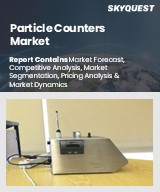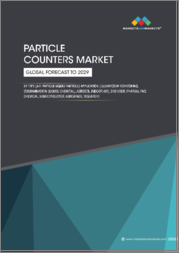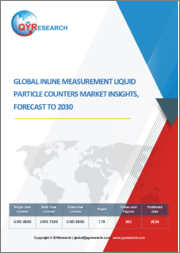
|
시장보고서
상품코드
1503422
파티클 카운터 시장 예측(-2030년) : 유형별, 모달리티별, 기술별, 용도별, 최종사용자별, 지역별 세계 분석Particle Counters Market Forecasts to 2030 - Global Analysis By Type (Airborne, Liquid, Dust, Condensation and Other Types), Modality, Technology, Application, End User and By Geography |
||||||
Stratistics MRC에 따르면 세계의 파티클 카운터 시장은 2024년에 6억 4,090만 달러에 달하며, 예측 기간 중 CAGR 12.0%로 성장하며, 2030년까지는 12억 6,560만 달러에 달할 전망입니다.
입자 계수기는 공기 또는 액체에 떠다니는 입자를 크기와 종종 성분에 따라 정량화 및 분류하는 데 사용되는 장비입니다. 빛 산란, 레이저 회절, 콜터 원리 등 다양한 기술을 사용하여 직경이 나노미터에서 마이크로미터에 이르는 입자를 감지하고 측정합니다.
미국연구제약산업협회(PhRMA)에 따르면 연구개발비에서 미국이 약 58%로 가장 높은 점유율을 차지하고 있습니다. 미국 전체 바이오의약품의 경우 2020년 연구개발에 약 1,220억 달러가 투자되었습니다.
실내 공기질에 대한 관심 증가
건강과 생산성에 미치는 영향에 대한 인식이 높아지면서 실내 공기질에 대한 관심이 높아지고 있습니다. 밀폐된 공간의 먼지, 알레르겐, 공기 중 병원균과 같은 오염 물질에 대한 우려로 인해 정확하고 효율적인 파티클 카운터에 대한 수요가 증가하고 있습니다. 이러한 장비는 가정, 사무실, 의료 시설 및 산업 환경의 공기질 모니터링에 필수적이며, 보다 안전하고 건강한 실내 환경을 보장하기 위한 사전 조치를 용이하게 해줍니다. 이러한 추세는 전 세계 실내 공간에서 예방적 건강 조치와 규제 준수에 대한 관심이 높아지고 있음을 보여줍니다.
인식 부족
미세먼지 측정 기술의 장점과 기능에 대한 잠재적 사용자의 인식 부족은 시장에서 큰 도전이 되고 있습니다. 많은 산업 분야에서 제품 품질을 유지하고 규제 준수를 보장하기 위해 공기질을 정밀하게 모니터링해야 합니다. 그러나 파티클 카운터의 복잡성과 다양한 용도는 종종 의사 결정자들이 혼란스러워하거나 제대로 이해하지 못하는 경우가 많습니다. 이러한 인식 부족은 채택률을 저해하고, 산업계가 첨단 파티클 카운팅 솔루션을 활용하여 프로세스와 결과를 개선하는 데 방해가 될 수 있습니다.
기술의 발전
최근 파티클 카운터의 발전은 정확성, 휴대성, 연결성을 향상시켜 시장에 혁명을 일으켰습니다. 부품의 소형화로 인해 다양한 환경에서 실시간 모니터링이 가능한 더 작고 다용도한 장비가 가능해졌고, IoT 기능의 통합으로 원격 모니터링과 데이터 분석이 가능해져 업무 효율성과 의사결정을 개선할 수 있게 되었습니다. 또한 센서 기술의 발전으로 감도가 향상되고 전력 소비가 줄어들어 배터리 수명이 길어졌습니다.
시스템의 높은 비용
이 시장은 높은 시스템 비용으로 인해 큰 어려움에 직면해 있으며, 이는 업계 전반의 보급에 영향을 미치고 있습니다. 통제된 환경에서 공기질과 청결을 모니터링하는 데 필수적인 이러한 첨단 장비는 조달과 유지보수 측면에서 많은 투자가 필요합니다. 비용 장벽은 소규모 조직과 시설의 접근을 제한하고 입자 모니터링 기술의 광범위한 도입을 방해하고 있습니다. 기능과 정확도의 발전에도 불구하고 제조업체는 정밀 측정 기기 분야에서 비용과 시장 경쟁력을 낮추기 위해 고군분투하고 있습니다.
COVID-19의 영향 :
COVID-19 팬데믹은 공기질 모니터링과 안전성을 보장하기 위해 의료, 제약, 클린룸 시설 전반에서 수요가 증가하면서 파티클카운터 시장에 큰 영향을 미치고 있습니다. 공기 중 감염에 대한 인식이 높아지면서 입자 측정 기술 채택이 증가했지만, 초기에는 공급망 혼란이 문제였습니다. 그러나 전 세계에서 더욱 엄격한 위생 및 안전 기준으로의 전환을 반영하여 원격 모니터링 및 감도 향상을 위한 기술 혁신을 통해 시장은 적응해 왔습니다.
예측 기간 중 광학식 파티클카운터 부문이 가장 큰 비중을 차지할 것으로 예상됩니다.
예측 기간 중 광학식 입자 계수기가 가장 큰 비중을 차지할 것으로 예상됩니다. 광학식 입자 계수기는 빛 산란 또는 레이저 회절 기술을 사용하여 입자 크기와 농도를 정확하게 측정하여 높은 감도와 신뢰성을 제공합니다. 광학식 파티클 카운터는 환경 모니터링 및 산업 위생 분야에 널리 사용되고 있으며, 규제 기준 준수를 보장하고 예방적 유지보수 전략을 가능하게 합니다. 실시간 데이터 제공이 가능하기 때문에 중요한 환경의 공기질과 오염 수준을 평가하는 데 필수적입니다.
예측 기간 중 가장 높은 CAGR을 보일 것으로 예상되는 분야는 반도체 부문입니다.
예측 기간 중 가장 높은 CAGR을 나타낼 것으로 예상되는 분야는 반도체 부문입니다. 이러한 장비는 포토다이오드 및 광전자 증배관과 같은 반도체 부품을 사용하여 입자에 의해 산란된 빛을 감지하여 다양한 크기와 유형의 입자를 정확하게 계수할 수 있도록 합니다. 반도체 기술은 입자 계수 용도의 신뢰성, 감도 및 효율성을 보장하며, 정확한 입자 측정이 안전 및 품질 표준을 유지하는 데 필수적인 환경 모니터링 및 의료 환경에서 필수적인 역할을 하고 있습니다.
가장 큰 점유율을 차지하는 지역
예측 기간 중 북미가 가장 큰 시장 점유율을 차지할 것으로 예상됩니다. 공기질 및 오염 관리에 대한 관심이 높아지면서 시장 확대가 더욱 가속화될 것으로 예상됩니다. 주요 기업은 다양한 용도에 대응하고 정확성과 효율성을 높이기 위해 기술 발전에 집중하고 있습니다. 또한 클린룸 기술에 대한 인식과 투자가 증가하면서 수요가 증가하고 있으며, 이는 이 지역 시장 경쟁과 발전에 기여하고 있습니다.
CAGR이 가장 높은 지역 :
예측 기간 중 아시아태평양이 가장 높은 CAGR을 유지할 것으로 예상됩니다. 대기 오염과 공중 보건에 미치는 영향에 대한 우려가 증가함에 따라 환경 모니터링 목적으로 입자 계수기의 도입이 증가하고 있습니다. 각국 정부와 환경 기관은 오염 수준을 평가하고 완화하기 위해 모니터링 시스템에 투자하고 있습니다. 대기질 및 오염 제어에 대한 엄격한 규제 요건으로 인해 산업계는 첨단 입자 측정 솔루션을 채택하고 있습니다.
무료 맞춤형 서비스 :
이 보고서를 구독하는 고객은 다음과 같은 무료 맞춤화 옵션 중 하나를 사용할 수 있습니다.
- 기업 개요
- 추가 시장 기업의 종합적인 프로파일링(최대 3사)
- 주요 기업의 SWOT 분석(최대 3사)
- 지역 세분화
- 고객의 관심에 따른 주요 국가별 시장 추정치, 예측, CAGR(주: 타당성 확인에 따라 다름)
- 경쟁사 벤치마킹
- 제품 포트폴리오, 지역적 입지, 전략적 제휴를 기반으로 한 주요 기업 벤치마킹
목차
제1장 주요 요약
제2장 서문
- 개요
- 이해관계자
- 조사 범위
- 조사 방법
- 데이터 마이닝
- 데이터 분석
- 데이터 검증
- 아치 어프로치
- 조사 정보원
- 1차 조사 정보원
- 2차 조사 정보원
- 전제조건
제3장 시장 동향 분석
- 촉진요인
- 억제요인
- 기회
- 위협
- 기술 분석
- 용도 분석
- 최종사용자 분석
- 신흥 시장
- COVID-19의 영향
제4장 Porter's Five Forces 분석
- 공급 기업의 교섭력
- 구매자의 교섭력
- 대체품의 위협
- 신규 진출업체의 위협
- 경쟁 기업간 경쟁 관계
제5장 세계의 파티클 카운터 시장 : 유형별
- 공중
- 액체
- 분진
- 결로
- 기타 유형
제6장 세계의 파티클 카운터 시장 : 모달리티별
- 휴대용
- 핸드헬드
- 리모트
제7장 세계의 파티클 카운터 시장 : 기술별
- 광학 파티클 카운터
- 응축 파티클 카운터(CPC)
- 쿨터 카운터
- 레이저 파티클 카운터
- SMPS(Scanning Mobility Particle Sizers)
- 기타 기술
제8장 세계의 파티클 카운터 시장 : 용도별
- 클린룸 모니터링
- 실내공기질 모니터링
- 야외 대기오염 모니터링
- 액체 품질관리
- 환경 모니터링
- 에어로졸 조사
- 기타 용도
제9장 세계의 파티클 카운터 시장 : 최종사용자별
- 헬스케어
- 반도체
- 자동차
- 항공우주
- 식품 및 음료
- 헬스케어
- 기타 최종사용자
제10장 세계의 파티클 카운터 시장 : 지역별
- 북미
- 미국
- 캐나다
- 멕시코
- 유럽
- 독일
- 영국
- 이탈리아
- 프랑스
- 스페인
- 기타 유럽
- 아시아태평양
- 일본
- 중국
- 인도
- 호주
- 뉴질랜드
- 한국
- 기타 아시아태평양
- 남미
- 아르헨티나
- 브라질
- 칠레
- 기타 남미
- 중동 및 아프리카
- 사우디아라비아
- 아랍에미리트
- 카타르
- 남아프리카공화국
- 기타 중동 및 아프리카
제11장 주요 발전
- 계약, 파트너십, 협업, 합병사업
- 인수·합병
- 신제품 발매
- 사업 확대
- 기타 주요 전략
제12장 기업 프로파일링
- Beckman Coulter Life Sciences
- TSI Incorporated
- Olympus Corporation
- Kanomax USA, Inc.
- Teledyne API
- Met One Instruments, Inc.
- RAE Systems
- Fluke Corporation
- Particle Measuring Systems
- Climet Instruments Company
- Lighthouse Worldwide Solutions
- Parker Hannifin Corporation
- Aeroqual Ltd.
- Particle Plus
- Hal Technology LLC
According to Stratistics MRC, the Global Particle Counters Market is accounted for $640.9 million in 2024 and is expected to reach $1265.6 million by 2030 growing at a CAGR of 12.0% during the forecast period. Particle counters are instruments used to quantify and classify particles suspended in air or liquids based on their size and often composition. They employ various techniques such as light scattering, laser diffraction, or Coulter principle to detect and measure particles ranging from nanometers to micrometers in diameter.
According to the Pharmaceutical Researchers and Manufacturers of America (PhRMA), the United States has the highest share of around 58% in terms of R&D expenditure. The entire United States biopharmaceutical invested an estimated 122 billion USD in research and development in 2020.
Market Dynamics:
Driver:
Growing focus on indoor air quality
The market is witnessing a growing emphasis on indoor air quality, driven by increasing awareness of its impact on health and productivity. With concerns over pollutants like dust, allergens, and airborne pathogens in enclosed spaces, there's a rising demand for accurate and efficient particle counters. These devices are crucial for monitoring air quality in homes, offices, healthcare facilities, and industrial settings, facilitating proactive measures to ensure safer and healthier indoor environments. This trend underscores a shift towards preventative health measures and regulatory compliance in indoor spaces worldwide.
Restraint:
Lack of awareness
In the market, a significant challenge lies in the lack of awareness among potential users about the benefits and functionalities of particle counting technology. Many industries require precise monitoring of air quality to maintain product quality and ensure regulatory compliance. However, the complexity of particle counters and their varied applications often lead to confusion or insufficient understanding among decision-makers. This lack of awareness can hinder adoption rates and prevent industries from leveraging advanced particle counting solutions to improve their processes and outcomes.
Opportunity:
Advancements in technology
Recent advancements in particle counters have revolutionized the market with enhanced accuracy, portability, and connectivity. Miniaturization of components allows for smaller, more versatile devices capable of real-time monitoring in diverse environments. Integration of IoT capabilities enables remote monitoring and data analysis, improving operational efficiency and decision-making. Additionally, advancements in sensor technology have boosted sensitivity and reduced power consumption, extending battery life.
Threat:
High cost of systems
The market faces significant challenges due to the high costs of systems, impacting widespread adoption across industries. These sophisticated instruments, crucial for monitoring air quality and cleanliness in controlled environments, require substantial investment in both procurement and maintenance. The cost barrier limits access for smaller organizations and facilities, hindering broader implementation of particle monitoring technology. Despite advancements in functionality and accuracy, manufacturers struggle to mitigate expenses and market competitiveness in the realm of precision measurement instruments.
Covid-19 Impact:
The COVID-19 pandemic significantly impacted the Particle Counters market, with increased demand across healthcare, pharmaceuticals, and cleanroom facilities for monitoring air quality and ensuring safety. Heightened awareness of airborne transmission drove the adoption of particle counting technologies, while disruptions in supply chains initially posed challenges. However, the market adapted with innovations in remote monitoring and enhanced sensitivity, reflecting a shift towards more stringent hygiene and safety standards worldwide.
The optical particle counters segment is expected to be the largest during the forecast period
The optical particle counters is expected to be the largest during the forecast period. They utilize light scattering or laser diffraction techniques to accurately measure particle sizes and concentrations, offering high sensitivity and reliability. Optical particle counters are widely employed in environmental monitoring, and industrial hygiene applications, ensuring compliance with regulatory standards and enabling proactive maintenance strategies. Their ability to provide real-time data makes them indispensable for assessing air quality and contamination levels in critical settings.
The semiconductor segment is expected to have the highest CAGR during the forecast period
The semiconductor segment is expected to have the highest CAGR during the forecast period. These devices utilize semiconductor components such as photodiodes and photomultiplier tubes to detect light scattered by particles, enabling accurate particle counting across various sizes and types. The semiconductor technology ensures reliability, sensitivity, and efficiency in particle counting applications, making it indispensable in environmental monitoring and healthcare settings where precise particle measurement is essential for maintaining safety and quality standards
Region with largest share:
North America is projected to hold the largest market share during the forecast period driven by stringent regulatory requirements across industries. Increasing concerns regarding air quality and contamination control further propel market expansion. Key players are focusing on technological advancements to enhance accuracy and efficiency, catering to diverse applications. The demand is also bolstered by rising awareness and investment in cleanroom technologies, contributing to a competitive and evolving market landscape in the region.
Region with highest CAGR:
Asia Pacific is projected to hold the highest CAGR over the forecast period. Growing concerns about air pollution and its impact on public health have led to increased deployment of particle counters for environmental monitoring purposes. Governments and environmental agencies in countries are investing in monitoring systems to assess and mitigate pollution levels. Stringent regulatory requirements regarding air quality and contamination control are pushing industries to adopt advanced particle counting solutions002E
Key players in the market
Some of the key players in Particle Counters market include Beckman Coulter Life Sciences, TSI Incorporated, Olympus Corporation, Kanomax USA, Inc., Teledyne API, Met One Instruments, Inc., RAE Systems, Fluke Corporation, Particle Measuring Systems, Climet Instruments Company, Lighthouse Worldwide Solutions, Parker Hannifin Corporation, Aeroqual Ltd., Particle Plus, and Hal Technology LLC.
Key Developments:
In August 2023, Teledyne FLIR Introduced affordable handheld 6-channel particle counter for monitoring workplace environmental health and air quality. The VPC260 gives users the ability to customize settings for the display, sample methods, and alarm settings for the sample count.
In March 2023, TSI announced the availability of the new AeroTrak(R)+ Portable Particle Counter A100 Series. Whether working in pharmaceutical manufacturing, semiconductor and electronics manufacturing, or cleanroom certification, this instrument is engineered to meet user specific needs to help identify potential sources of environmental contamination and track changes in particle levels over time in cleanroom spaces.
Types Covered:
- Airborne
- Liquid
- Dust
- Condensation
- Other Types
Modalities Covered:
- Portable
- Handheld
- Remote
Technologies Covered:
- Optical Particle Counters
- Condensation Particle Counters (CPC)
- Coulter Counters
- Laser Particle Counters
- Scanning Mobility Particle Sizers (SMPS)
- Other Technologies
Applications Covered:
- Cleanroom Monitoring
- Indoor Air Quality Monitoring
- Outdoor Air Pollution Monitoring
- Liquid Quality Control
- Environmental Monitoring
- Aerosol Research
- Other Applications
End Users Covered:
- Healthcare
- Semiconductor
- Automotive
- Aerospace
- Food & Beverage
- Healthcare
- Other End Users
Regions Covered:
- North America
- US
- Canada
- Mexico
- Europe
- Germany
- UK
- Italy
- France
- Spain
- Rest of Europe
- Asia Pacific
- Japan
- China
- India
- Australia
- New Zealand
- South Korea
- Rest of Asia Pacific
- South America
- Argentina
- Brazil
- Chile
- Rest of South America
- Middle East & Africa
- Saudi Arabia
- UAE
- Qatar
- South Africa
- Rest of Middle East & Africa
What our report offers:
- Market share assessments for the regional and country-level segments
- Strategic recommendations for the new entrants
- Covers Market data for the years 2022, 2023, 2024, 2026, and 2030
- Market Trends (Drivers, Constraints, Opportunities, Threats, Challenges, Investment Opportunities, and recommendations)
- Strategic recommendations in key business segments based on the market estimations
- Competitive landscaping mapping the key common trends
- Company profiling with detailed strategies, financials, and recent developments
- Supply chain trends mapping the latest technological advancements
Free Customization Offerings:
All the customers of this report will be entitled to receive one of the following free customization options:
- Company Profiling
- Comprehensive profiling of additional market players (up to 3)
- SWOT Analysis of key players (up to 3)
- Regional Segmentation
- Market estimations, Forecasts and CAGR of any prominent country as per the client's interest (Note: Depends on feasibility check)
- Competitive Benchmarking
- Benchmarking of key players based on product portfolio, geographical presence, and strategic alliances
Table of Contents
1 Executive Summary
2 Preface
- 2.1 Abstract
- 2.2 Stake Holders
- 2.3 Research Scope
- 2.4 Research Methodology
- 2.4.1 Data Mining
- 2.4.2 Data Analysis
- 2.4.3 Data Validation
- 2.4.4 arch Approach
- 2.5 Research Sources
- 2.5.1 Primary Research Sources
- 2.5.2 Secondary Research Sources
- 2.5.3 Assumptions
3 Market Trend Analysis
- 3.1 Introduction
- 3.2 Drivers
- 3.3 Restraints
- 3.4 Opportunities
- 3.5 Threats
- 3.6 Technology Analysis
- 3.7 Application Analysis
- 3.8 End User Analysis
- 3.9 Emerging Markets
- 3.10 Impact of Covid-19
4 Porters Five Force Analysis
- 4.1 Bargaining power of suppliers
- 4.2 Bargaining power of buyers
- 4.3 Threat of substitutes
- 4.4 Threat of new entrants
- 4.5 Competitive rivalry
5 Global Particle Counters Market, By Type
- 5.1 Introduction
- 5.2 Airborne
- 5.3 Liquid
- 5.4 Dust
- 5.5 Condensation
- 5.6 Other Types
6 Global Particle Counters Market, By Modality
- 6.1 Introduction
- 6.2 Portable
- 6.3 Handheld
- 6.4 Remote
7 Global Particle Counters Market, By Technology
- 7.1 Introduction
- 7.2 Optical Particle Counters
- 7.3 Condensation Particle Counters (CPC)
- 7.4 Coulter Counters
- 7.5 Laser Particle Counters
- 7.6 Scanning Mobility Particle Sizers (SMPS)
- 7.7 Other Technologies
8 Global Particle Counters Market, By Application
- 8.1 Introduction
- 8.2 Cleanroom Monitoring
- 8.3 Indoor Air Quality Monitoring
- 8.4 Outdoor Air Pollution Monitoring
- 8.5 Liquid Quality Control
- 8.6 Environmental Monitoring
- 8.7 Aerosol Research
- 8.8 Other Applications
9 Global Particle Counters Market, By End User
- 9.1 Introduction
- 9.2 Healthcare
- 9.3 Semiconductor
- 9.4 Automotive
- 9.5 Aerospace
- 9.6 Food & Beverage
- 9.7 Healthcare
- 9.8 Other End Users
10 Global Particle Counters Market, By Geography
- 10.1 Introduction
- 10.2 North America
- 10.2.1 US
- 10.2.2 Canada
- 10.2.3 Mexico
- 10.3 Europe
- 10.3.1 Germany
- 10.3.2 UK
- 10.3.3 Italy
- 10.3.4 France
- 10.3.5 Spain
- 10.3.6 Rest of Europe
- 10.4 Asia Pacific
- 10.4.1 Japan
- 10.4.2 China
- 10.4.3 India
- 10.4.4 Australia
- 10.4.5 New Zealand
- 10.4.6 South Korea
- 10.4.7 Rest of Asia Pacific
- 10.5 South America
- 10.5.1 Argentina
- 10.5.2 Brazil
- 10.5.3 Chile
- 10.5.4 Rest of South America
- 10.6 Middle East & Africa
- 10.6.1 Saudi Arabia
- 10.6.2 UAE
- 10.6.3 Qatar
- 10.6.4 South Africa
- 10.6.5 Rest of Middle East & Africa
11 Key Developments
- 11.1 Agreements, Partnerships, Collaborations and Joint Ventures
- 11.2 Acquisitions & Mergers
- 11.3 New Product Launch
- 11.4 Expansions
- 11.5 Other Key Strategies
12 Company Profiling
- 12.1 Beckman Coulter Life Sciences
- 12.2 TSI Incorporated
- 12.3 Olympus Corporation
- 12.4 Kanomax USA, Inc.
- 12.5 Teledyne API
- 12.6 Met One Instruments, Inc.
- 12.7 RAE Systems
- 12.8 Fluke Corporation
- 12.9 Particle Measuring Systems
- 12.10 Climet Instruments Company
- 12.11 Lighthouse Worldwide Solutions
- 12.12 Parker Hannifin Corporation
- 12.13 Aeroqual Ltd.
- 12.14 Particle Plus
- 12.15 Hal Technology LLC



















